Ford to reveal solar-powered C-Max Solar Energi Concept car
New concept uses 'magnifying glass' canopies to focus sunlight onto roof-mounted solar panels, with a final range range of 550 miles

Ford is set to reveal a new hybrid car that will be partly powered by solar panels on the roof. Although there are no plans to sell the C-Max Solar Energi Concept to the public, the technology developed by the car-manufacturer could eventually find its way into commercial vehicles.
Coupling solar-power with electric cars is not a new idea, butmany previous iterations have been hamstrung by the a recurrentchallenge: the fact that solar panels simply aren't efficientenough to power a car, even if you leave a vehicle out in the sunall day long.
Ford has introduced a new to combat this in the form of a "solarconcentrator": a steel frame that essentially acts as a giantmagnifying class for the vehicle, although it's made from plasticrather than glass.
Users park their car under the five metre tall canopy, usingthis to focus the sun’s rays onto the roof-mounted solar panelswith a surface area five times larger than that which would beprovided by the vehicle alone.
In order to further increase the efficiency of this process thevehicle will also position itself autonomously underneath theconcentrator, moving back and forth to track the sun across thesky.
The Energi Concept will get the same performance as thecommercially available C-Max Energi that it's based on (anotherhybrid - but one that requires an electrical plug to charge it up),with a range of 620 miles and ability to travel for up to 21 milesfrom solar power alone.
"By using renewable power, the C-MAX Solar Energi Concept isestimated to reduce the annual greenhouse gas emissions (GHG) froma typical owner by four metric tons," says Ford.
However, as MIT Tech Review have noted, there are stillquite a few problems with the technology, including some fairlybasic ones, like keeping people from walking underneath the canopyand getting burned by the focused sunlight.
Subscribe to Independent Premium to bookmark this article
Want to bookmark your favourite articles and stories to read or reference later? Start your Independent Premium subscription today.

Join our commenting forum
Join thought-provoking conversations, follow other Independent readers and see their replies